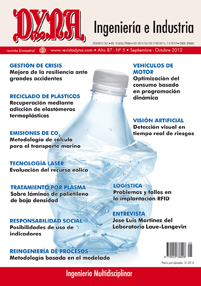SISTEMAS DE EVALUACIÓN DEL RECURSO EÓLICO: INTEGRACIÓN DE NUEVAS SOLUCIONES BASADAS EN TECNOLOGÍA LÁSER
Palabras clave:
energías renovables, energía eólica, anemómetro, LIDAR, estimación del recurso eólico, renewable energy, wind energy, anemometer, wind resource assessmentResumen
El potencial eólico de una localización geográfica está directamente relacionado con los perfiles de viento existentes en la misma. Su aprovechamiento está determinado por la curva de potencia del aerogenerador, la cual relaciona la velocidad de viento incidente sobre el rotor eólico con la potencia generada por el aerogenerador. Según la Norma Internacional vigente relativa al cálculo de la curva de potencia de aerogeneradores, la velocidad del viento a la altura del buje es el parámetro principal de entrada para la caracterización de dicha curva, junto al parámetro de densidad del aire como factor secundario. La afirmación anterior supone que la velocidad del viento es constante en toda el área barrida del rotor eólico. Cuando se trata de aerogeneradores de pequeño tamaño, dicha suposición se puede acercar con cierto grado de exactitud a la realidad; pero en los aerogeneradores actuales dotados de grandes diámetros conduce a errores significativos; ya que la velocidad de viento varía considerablemente a lo largo del área barrida por el rotor. Además, es importante mencionar que, en breve, se producirá la reforma de la Normativa anterior, en la que se empezará a tener en cuenta mayor número de medidas dentro del rotor. El presente artículo analiza las nuevas técnicas de medición de la velocidad y dirección del viento basadas en tecnología remota: SODAR y LIDAR. Estas soluciones permiten obtener perfiles de viento dentro de un amplio rango de alturas, lo cual supone clara mejora en comparación con los sistemas convencionales.Descargas
Publicado
2012-09-01
Número
Sección
ARTICULOS

